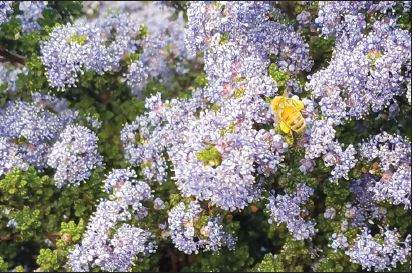Alameda Sun – Wednesday, June 9, 2021
by Birgitt Evans, Board member of Alameda Backyard Growers and Master Gardener

Photo: Birgitt Evans Many insects like this honey bee rely on the early flowers of native Ceanothus bushes.
It’s June now and the garden is planted and beginning to take off. Also taking off are those organisms people identify as “pests.” Contrary to most articles, this one is not going to focus on how to kill insects, but rather on what people can do to create functioning ecosystems in their gardens in which organisms are not labeled “good” or “bad,” but in which organisms work in conjunction with one another to regulate each other’s populations. Creating a balanced ecosystem will result in less pest damage and less work for the gardener.
In November 2018, the New York Times published an article entitled “The Insect Apocalypse is Here,” citing several research papers which found dramatic reductions in the numbers of insects and other small organisms such as spiders which form the foundation of ecosystems. Subsequent scientific studies have backed this up. Additionally, the World Wildlife Fund’s “Living Planet Report 2020” found, “Globally, monitored population sizes of mammals, fish, birds, reptiles and amphibians have declined an average of 68% between 1970 and 2016.” Given this precipitous decline, it seems important to create self-regulating ecosystems, rather than focusing on killing specific organisms without harming everything else.
To do that, begin by looking around and becoming familiar with what functioning ecosystems should look like. Find attractive, diverse gardens while walking – especially those with California native plants – and stand and observe what they contain. Visit a botanical garden or native plant nursery and ask questions. Everything feeds on something and everything is, in turn, eaten by something. Knowing what animals eat will help in the planning. For instance, up to 80% of a hummingbird’s diet consists of insects and spiders. And most songbirds, including seed-eaters, feed their chicks approximately 70% caterpillars. In other words, no spiders means no hummingbirds, and no caterpillars means fewer baby birds will survive. Calscape.org lists all the wildlife that utilizes a given plant.
Healthy, self-regulating gardens are diverse. Even a vegetable garden should include food, water and shelter for a variety of organisms. Water should be changed often to prevent disease transmission and should be offered at different heights and depths so that birds and insects can drink without danger of drowning. A brush pile and some dense shrubs will provide safe spaces for birds to shelter and nest in. And be sure that animals can move from one garden to another both over and under fences.
Insects are often the base level of an ecosystem. They eat diverse food sources. We are most aware of the herbivores that eat plant leaves or suck plant sap. Left alone, these will attract carnivores such as lady beetles and lacewings, whose larva will consume large numbers of aphids or whiteflies on their way to becoming adults. Keep in mind that predator populations are a month or so behind their prey. Many adult insects such as lady beetles and lacewings also feed on pollen. They have short mouth parts and require open daisy shaped or umbelliferous flowers to feed from. And since some insects are herbivores, it is important to learn to accept some level of cosmetic damage to both crops and ornamental plants. An uneaten milkweed or fennel plant is a failure.
Moving up the food web, many birds will eat insects. A flock of bush tits will feast on the aphids and scale on a lemon tree and use those to feed their babies. Bats also eat insects. And hawks and owls will eat rodents. Raccoons and opossums eat a wide variety of foods, including grubs, worms, insects, fruit and bird eggs. And don’t forget seeds for seed-eating birds like finches and doves. As long as a habitat has food, water and shelter for a wide variety of organisms it will eventually come into balance and “pest” populations will be reduced by the organisms that feed on them, limiting damage to plants.
Until that happens, however, there are a few other ways to protect crops and sensitive plants.
Many insects, such as aphids, white flies and cucumber beetles are only present in the summertime and die out over the winter. Cool season crops can be planted in the fall and grown through the winter to entirely avoid aphids, whiteflies and leaf miners. Ornamental plants can be started in October with the fall rains so that they are well established and better able to withstand damage from scale and herbivorous insects and birds.
Mechanical controls such as cages and floating row covers can keep insects, birds and mammals away from edible crops or young plants. Copper barriers and wood ashes can keep out snails and slugs. Sticky barriers such as Tanglefoot on tree trunks can prevent Argentine ants from farming scale or aphids on fruit trees.
Added to the biological controls created by a diverse habitat, timing plantings and mechanical controls can reduce significant damage to plants. And never forget the role of healthy, compost-enriched soil and correct applications of fertilizer play in growing healthy plants that will resist both disease and damage from herbivorous insects.
Adding all of these things together will create gardens that are beautiful, healthy and that provide the habitat that wildlife really needs right now. It will take a few years, but eventually the gardener will have much less to do and be able to enjoy the fruits of their labor.
Read the original article in the Alameda Sun here – and support our local newspaper by buying a subscription!
